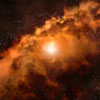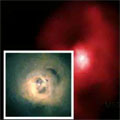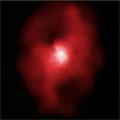CXC Home | Search | Help | Image Use Policy | Latest Images | Privacy | Accessibility | Glossary | Q&A

Animation of Eruption from
Supermassive Black Hole
QuickTime MPEG This animation depicts an eruption caused by a supermassive black hole. Gas and dust (reddish-brown disk) are being pulled around by the enormous gravity of the supermassive black hole, which is buried in the center of a large elliptical galaxy. The animation then zooms out to show the full view of the galaxy, which is surrounded by hot gas (red) that pervades the galaxy cluster. White jets, fueled from material falling onto the black hole, then erupt from the black hole and push gas backwards to create the dark cavities in the cluster gas.
[Run Time: 0:17]
(Animation: NASA/CXC/A.Hobart)
View Still Images of Black Hole Eruption
Supermassive Black Hole
QuickTime MPEG This animation depicts an eruption caused by a supermassive black hole. Gas and dust (reddish-brown disk) are being pulled around by the enormous gravity of the supermassive black hole, which is buried in the center of a large elliptical galaxy. The animation then zooms out to show the full view of the galaxy, which is surrounded by hot gas (red) that pervades the galaxy cluster. White jets, fueled from material falling onto the black hole, then erupt from the black hole and push gas backwards to create the dark cavities in the cluster gas.
[Run Time: 0:17]
(Animation: NASA/CXC/A.Hobart)
View Still Images of Black Hole Eruption

Size Comparison of MS 0735.6+7421 &
Perseus Cluster
QuickTime MPEG This sequence compares the physical size of the cavities found in MS 0735.6+7421 and the Perseus cluster, another well-known galaxy cluster with cavities. These two clusters are at very different distances -- Perseus is about 250 million light years away and MS 0735 is almost three billion light years away. To make a direct size comparison, the Perseus cluster is shrunk to simulate its appearance at the farther distance of MS 0735. From this comparison, it is obvious that the cavities in MS 0735 are much larger than those found in Perseus.
[Run Time: 0:12]
(Credit: MS 0735: NASA/CXC/Ohio U./B.McNamara et al.; Perseus: NASA/CXC/IoA/A.Fabian et al.)
Perseus Cluster
QuickTime MPEG This sequence compares the physical size of the cavities found in MS 0735.6+7421 and the Perseus cluster, another well-known galaxy cluster with cavities. These two clusters are at very different distances -- Perseus is about 250 million light years away and MS 0735 is almost three billion light years away. To make a direct size comparison, the Perseus cluster is shrunk to simulate its appearance at the farther distance of MS 0735. From this comparison, it is obvious that the cavities in MS 0735 are much larger than those found in Perseus.
[Run Time: 0:12]
(Credit: MS 0735: NASA/CXC/Ohio U./B.McNamara et al.; Perseus: NASA/CXC/IoA/A.Fabian et al.)

Chandra Image & Artist Illustration of
MS 0735.6+7421
QuickTime MPEG This sequence shows three frames: the Chandra X-ray image of the galaxy cluster MS 0735, a labeled illustration of the system, then a return to the Chandra image. The two giant cavities (dark red regions) found in the X-ray emitting, hot gas (bright red) in the galaxy cluster are evidence for the massive eruption. A supermassive black hole at the center of the bright X-ray emission caused the eruption.
[Run Time: 0:20]
(Credit: X-ray image: NASA/CXC/Ohio U./B.McNamara et al.; Illustration: NASA/CXC/M.Weiss)
MS 0735.6+7421
QuickTime MPEG This sequence shows three frames: the Chandra X-ray image of the galaxy cluster MS 0735, a labeled illustration of the system, then a return to the Chandra image. The two giant cavities (dark red regions) found in the X-ray emitting, hot gas (bright red) in the galaxy cluster are evidence for the massive eruption. A supermassive black hole at the center of the bright X-ray emission caused the eruption.
[Run Time: 0:20]
(Credit: X-ray image: NASA/CXC/Ohio U./B.McNamara et al.; Illustration: NASA/CXC/M.Weiss)
Return to MS 0735.6+7421 (05 Jan 05)


